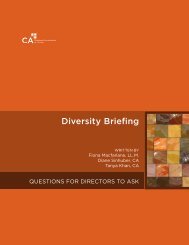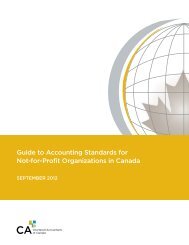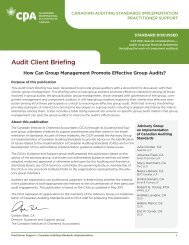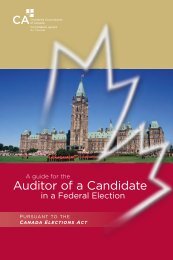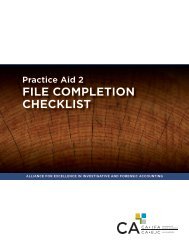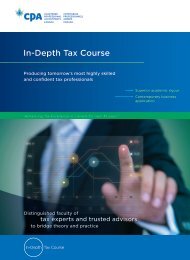20 Questions - Canadian Institute of Chartered Accountants
20 Questions - Canadian Institute of Chartered Accountants
20 Questions - Canadian Institute of Chartered Accountants
You also want an ePaper? Increase the reach of your titles
YUMPU automatically turns print PDFs into web optimized ePapers that Google loves.
<strong>20</strong> <strong>Questions</strong>Directors <strong>of</strong> Not-For-Pr<strong>of</strong>it Organizations Should Ask aboutStrategy and PlanningHugh Lindsay, FCA, CIP
How to use this publicationEach “<strong>20</strong> <strong>Questions</strong>” publication is designed to be a concise, easy-to-read introduction to an issue <strong>of</strong> importance to directors. The question format reflectsthe oversight role <strong>of</strong> directors which includes asking a lot <strong>of</strong> questions. For each question there is a brief explanatory background and some recommendedpractices.The questions are intended to be relevant to most not-for-pr<strong>of</strong>it organizations. The “answers” or comments that accompany the questions summarize currentthinking on the issues and practices <strong>of</strong> not-for-pr<strong>of</strong>it governance. There are many views on the best way to govern and manage not-for-pr<strong>of</strong>it organizations anda number <strong>of</strong> governance models. This document describes general principles that apply in most situations. If your organization has a different approach, youare encouraged to test it by asking if it provides a valid answer to the question.After the comments there are lists <strong>of</strong> recommended practices that directors can use to assess their understanding <strong>of</strong> their organization and to prompt furtherquestions if they are not fully satisfied with the answers. They represent aspirations, not absolute standards that must be met immediately.Directors who come from a for-pr<strong>of</strong>it business may find that their experience, although helpful, will not always provide the best answers in the not-for-pr<strong>of</strong>itenvironment. Appendix 1 compares and contrasts corporate and not-for-pr<strong>of</strong>it governance.Readers who want more details on specific topics may refer to the section on “Where to Find More Information.” Most <strong>of</strong> the CICA <strong>20</strong> <strong>Questions</strong> series <strong>of</strong>publications for directors were written for business boards but are relevant to not-for-pr<strong>of</strong>it boards.AuthorHugh Lindsay, FCA, CIPProject direction byBeth Deazeley, LL.B., Principal, Risk Management and Governance, CICAINSTITUTEOF COR PORATEDI R ECTORS
<strong>20</strong> <strong>Questions</strong>Directors <strong>of</strong> Not-For-Pr<strong>of</strong>it Organizations Should Ask aboutStrategy and Planning
Library and Archives Canada Cataloguing in PublicationLindsay, Hugh<strong>20</strong> questions directors <strong>of</strong> not-for-pr<strong>of</strong>it organizations should ask about strategy andplanning.ISBN 978-1-55385-331-21. Nonpr<strong>of</strong>it organizations--Management. 2. Strategic planning. 3. Boards<strong>of</strong> directors. I. <strong>Canadian</strong> <strong>Institute</strong> <strong>of</strong> <strong>Chartered</strong> <strong>Accountants</strong> II. Title.III. Title: Twenty questions directors <strong>of</strong> not-for-pr<strong>of</strong>it organizations shouldask about strategy and planning.HD30.28.T84 <strong>20</strong>08 658.4’012 C<strong>20</strong>08-901155-4Copyright © <strong>20</strong>08<strong>Canadian</strong> <strong>Institute</strong> <strong>of</strong> <strong>Chartered</strong> <strong>Accountants</strong>277 Wellington Street WestToronto, ON M5V 3H2Printed in CanadaDisponible en français
PrefaceThe Risk Management and Governance Board <strong>of</strong> the <strong>Canadian</strong> <strong>Institute</strong> <strong>of</strong><strong>Chartered</strong> <strong>Accountants</strong> (RMGB) has developed this briefing to help members<strong>of</strong> not-for-pr<strong>of</strong>it boards <strong>of</strong> directors understand their responsibility for strategy,planning and budgeting. It is intended primarily to help not-for-pr<strong>of</strong>it directorsunderstand:• The role <strong>of</strong> the board in developing and approving strategy, plans andbudgets• The reasons for planning and budgeting• The processes by which strategies, plans and budgets are typically developedand approved.Not-for-pr<strong>of</strong>it organizations are very diverse and range from small all-volunteergroups to large, sophisticated enterprises. This document is primarily intendedfor organizations with an executive director and staff resources who can preparethe strategic and operational plans and budgets with strategic direction andapproval from the board.Strategic Planning is most likely to be effective when the organization hasa carefully selected and well-balanced board that practices good governanceas described in CICA’s <strong>20</strong> <strong>Questions</strong> Directors <strong>of</strong> Not-For-Pr<strong>of</strong>it OrganizationsShould Ask about Governance.The Risk Management and Governance Board acknowledges and thanks themembers <strong>of</strong> the Not-for-Pr<strong>of</strong>it Organizations Task Force for their invaluableadvice, Hugh Lindsay, FCA, who wrote this briefing under their guidance andthe CICA staff, who provided support to the project.Tom Peddie, FCAChair, Risk Management and Governance BoardRisk Management and Governance BoardThomas Peddie, FCA, ChairDan Cornacchia, FCABrian Ferguson, CAJohn Fraser, CAAndrew J. MacDougall, LL.B.Michael B. Meagher, FCAPeter W. Roberts, FCA, CPA (Illinois)Directors Advisory GroupGiles Meikle, FCA, ChairJames Arnett, QCJohn Caldwell, CAWilliam A. Dimma, F.ICD, ICD.DJohn T. Ferguson, FCAGordon Hall, FSA, ICD.DCarol Hansell, LL.B.Mary Mogford, F.ICD, ICD.DPatrick O’CallaghanRonald W. Osborne, FCAGuylaine Saucier, CM, FCACICA StaffDave Pollard, CA, Vice President, Knowledge DevelopmentGigi Dawe, Principal, Risk Management and GovernanceBeth Deazeley, LL.B. Principal, Risk Management and Governance3
IntroductionThe sustainability <strong>of</strong> a not-for-pr<strong>of</strong>it organization – its ability to continue andfund its activities year after year – is a major responsibility <strong>of</strong> the board. Directorsneed to understand why the organization exists, the interests <strong>of</strong> its stakeholdersand how it manages the risks it faces. They should also be actively involved in thedevelopment and approval <strong>of</strong> its strategy.An organization’s “strategy” involves:(1) the determination <strong>of</strong> long term goals (i.e., mission, vision and values) andobjectives which reflect(a) the relationship that the organization wishes to have with itsdifferent stakeholder groups and,(b) in particular, how the organization intends to address importantstakeholder needs; and(2) the identification <strong>of</strong> the scope <strong>of</strong> the activities or programs throughwhich those goals and objectives are to be achieved. 1While other definitions <strong>of</strong> strategy exist, this approach is one that answers theessential questions <strong>of</strong> strategy with which every not-for-pr<strong>of</strong>it board membershould be concerned.The strategy should be approved by the board <strong>of</strong> directors and reviewed atleast annually. Even where the strategy does not radically change, the process <strong>of</strong>revisiting it can help to reenergize, refocus and renew the organization.Operational Planning and Budgeting are the processes for deciding what theorganization’s staff and volunteers will do to support the strategy in the nextyear or years, what this will cost and where the money will come from. Theboard should also approve the plans and budgets which are generally preparedby the organization’s staff. Board members who are more familiar with businessplanning may find the comparison between corporate and not-for-pr<strong>of</strong>it governancein Appendix 1 to be helpful.This document has three sections:Strategic PlanningOperational and Capital Planning and BudgetingMonitoring and Learning1 Adapted from: “Lasting inspiration” by Christopher K. Bart, in CAMagazine, May, <strong>20</strong>00, pp. 49-504
Strategic PlanningStrategic planning can be described as determining where the organization isnow, where it would like to be in the future, and how it intends to get there.Most not-for-pr<strong>of</strong>it organizations start <strong>of</strong>f with a fairly clear idea <strong>of</strong> what theywant to accomplish and what they stand for. The founding members spendtime talking about these things and, if they incorporate, they write them downas the purpose <strong>of</strong> the organization.Over time, the original passion and energy can get diluted by practicalitiesand problems, circumstances and needs may change and the organization riskslosing its sense <strong>of</strong> purpose, relevance and commitment. Strategic planning is away to invigorate and strengthen an organization by establishing longer rangeobjectives and focusing on the important - not just the urgent. The results <strong>of</strong>planning provide information for members and funding sources.Strategic planning also provides guidance to staff and volunteers for developingwork plans, projects and budgets and for the effective management <strong>of</strong> resources.A strategic plan describes how an organization intends to move from where it isnow towards its vision in accordance with its mission, values and tolerance forrisk. In so doing it plans to use its strengths to take advantage <strong>of</strong> opportunities,remedy its weaknesses and to avoid or mitigate threats. The plan alsoestablishes how the organization will measure progress in meeting its objectives.This section explores these concepts and concludes with discussions <strong>of</strong> theresponsibilities for planning and <strong>of</strong> how the planning elements described abovecan fit into a planning process. (<strong>Questions</strong> 11 and 12)Appendix 2 is an example <strong>of</strong> how all the elements in the planning process canfit together.1. What is the organization’s vision?There are no formal rules for visions – what organizations want to accomplish.Organizations adopt visions that work for them and inspire their members, staffand supporters. For example: vision statements may describe:• how things would be different as a result <strong>of</strong> the organization’s activities• how the organization wants to be seen by othersGood visions are aspirational. Some are hard-to-reach ideals as in MartinLuther King’s memorable words “I have a dream…”. Others are more modestor describe objectives that are achievable in the present or near future. In eithercase, the vision helps establish the unique contribution that the organizationmakes to society (the “value proposition” in business language) and providesjustification for support from its community, members, donors, sponsors andgovernment.From a practical perspective a vision can be a quick, memorable way to describethe organization’s reason for being. This can be valuable in times <strong>of</strong> difficultyor crisis when it helps to remember what is really important. For these andother reasons, the vision is <strong>of</strong>ten published in the organization’s annual reports,brochures and fund-raising materials.Recommended practices• The vision clearly explains what the organization aspires to accomplish• The board approves the vision• The vision is communicated to staff, volunteers, members and otherstakeholdersVisions“Creating a world where no <strong>Canadian</strong> fears cancer.”<strong>Canadian</strong> Cancer Society“Queen’s University will be recognized as an innovative, inclusiveand rigorous community <strong>of</strong> learning and discovery that is committedto serving as a national resource for the betterment <strong>of</strong> our globalsociety.”Queen’s UniversityVision and MissionActive Healthy Kids CanadaOur Vision: A nation <strong>of</strong> active, healthy kids.Our Mission: Active Healthy Kids Canada is committed to inspiringthe nation to engage all children and youth in physical activity.5
Strategic Planning y continued z2. How does the organization’s missionsupport its vision?The mission typically describes, in general terms, what an organization does toachieve its vision. Most missions emphasize action using such words as: support,involve, assist, contribute, provide, promote, etc. Because the vision is <strong>of</strong>tenexpressed as a dream or ideal, the mission helps clarify the practical aspects <strong>of</strong>what the organization will actually do.A good way to begin the review <strong>of</strong> the mission is to refer to the organization’sincorporation documents or equivalents. When an organization applies to beincorporated it must provide a description <strong>of</strong> its “purposes” - what it plans todo – which must meet prescribed eligibility requirements for not-for-pr<strong>of</strong>it and(if applicable) charitable status. Once approved, it may be that the purposes canonly be changed by application to the government body responsible for suchorganizations.The mission statement may be the same as the legal purposes or a restatement<strong>of</strong> the purposes in words that are more compatible with the organization’sculture and style. It must not, however, go beyond the purposes to cover activitieswhich the organization is not legally authorized to do. Most purposes aresufficiently broadly phrased and this is not usually a problem.A good mission statement is concise and precise. By summarizing what theorganization wants to do it answers the questions “Who are the stakeholders wewant to help?” and “How will we do this?”Recommended practices• The mission is compatible with the organization’s legal purposes and itsvision• The mission clearly identifies the organization’s key stakeholders and how theorganization will serve them• The board approves the mission• The mission is communicated to staff, volunteers, members and otherstakeholdersMissionsScouts CanadaTo contribute to the education <strong>of</strong> young people, through a valuesystem based on the Scout Promise and Law, to help build a betterworld where people are self-fulfilled as individuals and play aconstructive role in society.United Way <strong>of</strong> Halifax RegionThrough development and investment <strong>of</strong> resources, United Way<strong>of</strong> Halifax Region will bring people and organizations together tostrengthen neighbourhoods and build community capacity.3. What are this organization’s values?Not-for-pr<strong>of</strong>it organizations usually expect their strategies to be compatible withtheir values – the members’ beliefs about the right way to do things. Shared valuesinfluence everything the organization does, its relationships with its stakeholders,and its reputation. They include the standards <strong>of</strong> openness and honesty that arepracticed by the board and followed by staff and volunteers throughout the organization.These generally include complying with laws and regulations 2 but <strong>of</strong>tenextend beyond. Values may be expressed as beliefs, as guidelines or as rules.A code <strong>of</strong> conduct can be a valuable way to describe, clarify and communicatevalues. Organizations should adopt a code <strong>of</strong> conduct appropriate to theirstrategy, communicate and reinforce it, and review it regularly.Many organizations find it appropriate to have a code <strong>of</strong> conduct that iscomparable to those <strong>of</strong> other organizations in the same field <strong>of</strong> activity. Thecodes <strong>of</strong> pr<strong>of</strong>essional and other associations – (e.g. accountancy, law, education,medicine, sports, museums, libraries, etc) can be helpful starting points fordeveloping or adapting a code to fit the specific needs <strong>of</strong> an organization.62 Some advocacy groups may contest or reject laws they consider wrong and in need <strong>of</strong> change.
Strategic Planning y continued z8• The organization operates in a way that respects stakeholders and seeks tomeet their expectations - without letting them override the organization’svalues• The organization monitors stakeholder satisfaction on a regular basis5. How does the organization get themoney to fund its activities and programs?There are many ways to fund a not-for-pr<strong>of</strong>it organization. Each organizationshould aim to develop a funding strategy that is appropriate to its mode <strong>of</strong> operating,its mix <strong>of</strong> core program and project activities, and its funding priorities.These three types <strong>of</strong> activity each have different funding needs and opportunities– which can vary among organizations.Core activities are those that are essential to the organization’s sustainability– its capacity to exist and provide reliable delivery <strong>of</strong> its primary services. Theactivities typically include program delivery and the provision <strong>of</strong> resources tosupport them (buildings, equipment, supplies, information systems, etc). Coreactivities require the most predictable and secure funding which may comefrom such sources as endowment and investment income, membership dues,sustaining grants from governments, United Way grants, and well-establisheddonor development programs.Non-core program activities extend the organization’s capacity to provideimportant services. If necessary the organization can contract or discontinuethem and still be relevant. Non-core program activities can benefit from thesame funding sources as core activities. They may also generate their ownrevenues (fees, ticket and retail sales, etc), be eligible for special-purpose governmentgrants and secure sponsorship from businesses. In some cases, donors andsponsors may prefer to designate the support to programs rather than the organizationitself because they do not want to fund what they see as administrativeoverhead.Project activities typically address special, one-time needs that could bedeferred or cancelled if funding is not available – even though they <strong>of</strong>fer significantbenefits. They include responding to emergencies and opportunities toCore and non-coreThe difference between “core” and “non-core” is a matter <strong>of</strong>judgement. One approach is to ask “If we stopped doing this, couldwe still meet our primary objectives?”For example the core activity <strong>of</strong> a Women’s Crisis Shelter societymight be to provide emergency counseling and a safe shelter. Thesociety may also <strong>of</strong>fer related, “non-core”, services such as counselingand assistance with legal, medical, substance abuse, housing andemployment needs.Fund raisingThe competition for donations and sponsorships has become intense.Not-for-pr<strong>of</strong>it organizations are increasingly finding it necessary toengage pr<strong>of</strong>essional fund raisers - either as employees or outsideadvisors or service providers.Developing a steady flow <strong>of</strong> donations and sponsorships can be timeconsumingand expensive. It may be several years before the receiptssignificantly cover start-up and ongoing costs.improve the organization’s effectiveness – new buildings, equipment, systems,etc. Project activities may be funded from the previous sources or throughspecific appeals and grant applications. These include capital fund-raising campaigns,short-term project (or start-up) grants from charitable foundations andgovernment grants programs that match the amounts raised by organizations.In the short term, most organizations may not be in a position to change theirbasic funding model. They should, however, regularly reassess their strategiesfor raising funds because no source can be taken for granted. Many organizationshave found it necessary to find new sources <strong>of</strong> revenues as others havediminished. This may be done by adding programs designed to make pr<strong>of</strong>its,charging fees for traditionally free services or by increased fund raising fromindividual donors and businesses.
Recommended practices• The organization has stable, well-diversified sources <strong>of</strong> revenue• The organization is not overly dependent on discretionary government grants• The organization is prepared to deal with changes in funding levels from oneor more <strong>of</strong> its sources6. How do events in the organization and theworld outside affect our ability to achievethe mission and vision?Before an organization begins to develop its strategies it needs to understandwhere it is now. A commonly-used process for doing this is “SWOT analysis”:Strengths, Weaknesses, Opportunities, Threats. This is a simple model, easy tounderstand and use and appropriate for most mid-sized and small not-for-pr<strong>of</strong>itorganizations. SWOT analysis provides a “snapshot” <strong>of</strong> how well the organizationis positioned to achieve its vision and mission.Strengths and weaknesses are related to the internal factors and resourcesthat support the organization’s ability to get things done: staff, volunteers,membership, finances, donor support, buildings, equipment, etc. They describethe capacity <strong>of</strong> the organization to continue and extend its activities and theproblems that need attention. The review <strong>of</strong> strengths and weaknesses shouldinclude the systems for providing the financial, statistical and other informationneeded to support the organization’s ability to effectively manage its resourcesand deliver services.An organization’s strengths and weaknesses are usually in matters over whichits board and management have some degree <strong>of</strong> control. Lists <strong>of</strong> strengths andweaknesses are <strong>of</strong>ten developed by group brainstorming by staff and, whereappropriate, volunteers. In the process they draw on their experience andknowledge <strong>of</strong> the organization and consultation with stakeholders. The boardmay confirm or add to the list.Adapting strategies tochanging needs and opportunitiesThe War Amps was founded in 19<strong>20</strong> as The Amputations Association<strong>of</strong> The Great War, a fraternal society that provided direction to helpsolve the problems <strong>of</strong> all “men and women who have lost a limb orlimbs or complete eyesight whilst giving their service to Canada, theBritish Empire, and the Allies in the Great War.” Counselling, self-helpand practical assistance were emphasized.The Civilian Liaison Program began in 1953 in order that waramputees could share their knowledge with others who are missinglimbs from causes other than war.Realizing that war amputees were being well served by existingprograms and that in the future their needs would decrease, theorganization turned its attention to child amputees. In 1975 itstarted the Child Amputee (CHAMP) Program which tries to reachall amputee children and their families as soon after an amputationas possible, providing artificial limbs, education and counselling tohelp the children cope with their amputations. War Amps has alsointroduced accident awareness programs to reduce the incidence <strong>of</strong>amputations.The organization is now laying the groundwork for the time when waramputees will no longer be able to run the affairs <strong>of</strong> the Association.9
Strategic Planning y continued zOpportunities and Threats are external factors that can help or hinder theorganization: the economy, demographics, government policy, stakeholderneeds and preferences, etc. Opportunities include the unmet stakeholder needsand expectations that the organization could potentially serve. Threats includethe potential for increased costs and reduced financial support.Identifying external opportunities and threats requires a thorough understanding<strong>of</strong> the environment in which the organization operates, and the capacity torecognize events trends and other factors that could affect it. Board memberswho have knowledge and experience <strong>of</strong> issues that are relevant to the organizationcan be particularly valuable contributors to brainstorming sessions.Not-for-pr<strong>of</strong>it organizations typically have limited or no control over externalfactors. They may be able to influence government policy but, in most cases,they need to revise their strategies to meet changing circumstances. Boards havethe potential to play a significant role in supporting and/or promoting newstrategies or by participating in initiatives to influence government policy.The results <strong>of</strong> SWOT analysis can be used to:• Adjust or eliminate existing programs and projects• Add new programs or projects• Establish plans to resolve internal weaknessesRecommended practices• The organization considers its internal strengths and weaknesses indeveloping its strategic plan• The organization considers its external opportunities and threats indeveloping its strategic planSee CICA’s <strong>20</strong> <strong>Questions</strong> Directors Should Ask about Risk7. What risks does the organization face?SWOT analysis is closely related to risk management – the process that identifiesand addresses the risks that affect day-to-day operations and sustainability. Riskmanagement essentially asks:• What could happen that would affect our ability to meet our objectives?• How likely is it to occur?• How serious might it be?• What should we do to reduce the risk?• How can we be prepared to respond to problems?Boards <strong>of</strong> directors are responsible for monitoring the organization’s processesfor managing risk which should include:• Promoting an awareness <strong>of</strong> the need to manage risk• Identifying and assessing the risks that could affect the achievement <strong>of</strong> theirstrategy• Developing and implementing methods and procedures for managing risk• Learning from their experiences with risk.Managing risk is an ongoing responsibility <strong>of</strong> management who must followboard-approved policy and keep the board informed. The board can ensure thatit includes risk on its agenda by including a discussion <strong>of</strong> risk and opportunityin strategic planning sessions and by requiring the Executive Director to raisecurrent risk issues at board meetings. Organizations with an Audit Committeecan instruct the committee to review financial and other risk issues and reporton them to the board.Recommended practices• The organization has identified the major risks that could affect itsoperations and provides reports on them to the board• Management and the board consider risks when developing the strategicand operating plans• The organization has policies and procedures for managing risk• The board makes time in its agenda to discuss risk• The organization takes risks seriously and manages them well10
8. How much risk is appropriate?Effective organizations recognize that they must take advantage <strong>of</strong> opportunitiesto improve service to stakeholders and they also understand their “risk tolerance”– the amount and types <strong>of</strong> risk they are comfortable in assuming. Boards <strong>of</strong> directorsmust make sure that their organizations “optimize” risk by balancing risk andopportunity in accordance with risk tolerance levels approved by the board.The decision to adopt a strategy should include discussing:• Is this the best use <strong>of</strong> our resources?• Are we comfortable with the risks involved?“Nothing ventured, nothing gained” and “playing it safe” are two approaches torisk that can divide boards <strong>of</strong> directors and lead to long debates. The “venturers”see taking risks as the best way to succeed. The “play-it-safers” fear thatrisky strategies could destroy an organization that knows its limitations anddoes a good job <strong>of</strong> meeting its modest objectives.The board is responsible for approving the balance between the two approachesand providing strategic guidance and direction to staff. This may involve consideringthe spirit and attitudes <strong>of</strong> the members, stakeholders, board and staffand the values <strong>of</strong> the organization.A related factor is the organization’s “capacity for risk”: the strength <strong>of</strong> itsfinances, donor support, reputation and credibility, and the experience andcompetence <strong>of</strong> volunteers and staff.The board may choose to discuss and approve risk factors on an unstructured,case-by-case basis, or to approve a formal “risk tolerance” policy. In either caseit is valuable to record the discussion and decision for future reference.The main points to consider in risk-tolerance discussions and policies are:• The amount <strong>of</strong> money that the organization is prepared and able to lose if astrategy or project is less successful than anticipated: e.g. What would happenif a fund raising project loses money?• The potential risk to the organization’s reputation and credibility if a strategyor project is poorly received or otherwise unsuccessful.• The limits <strong>of</strong> the authority <strong>of</strong> the Executive Director or CEO – beyondwhich board approval is needed.• The information the board should receive before making its decision to grantapprovals.Recommended practices• The organization’s risk tolerance policy provides a balance between toomuch and too little risk taking• The risk tolerance policy is consistent with the organization’s capacity fortaking risk• The board approves the risk tolerance policy and reviews it at least annuallyRisky businessFund raising projects such as lotteries, golf tournaments, cruises,etc don’t always make money. Prizes, advertising and administrationcan be expensive. Public support is not automatic – particularlywhen there are popular competitors. The same can be true for“blockbuster” exhibits at museums and art galleries.Major fund-raising events and ambitious building projects areexamples <strong>of</strong> concentrating risk into one big initiative that can bringsuccess and recognition but requires confidence, competence,sustained dedication and an appetite for risk.Organizations with a lower tolerance for risk may have the capacitybut not the appetite for big risky ventures.11
Strategic Planning y continued z9. How sound are the assumptionsbehind the strategy?Behind every strategy and budget there are a number <strong>of</strong> assumptions. Thesemay or may not be valid. Experienced boards and managers know the value <strong>of</strong>challenging assumptions and considering what could be done if things turn outdifferently – a variety <strong>of</strong> “scenarios”.For example: an organization might develop its strategies on the assumptionthat:• It will continue to enjoy benefits it currently receives – government grants,the use <strong>of</strong> facilities at reasonable cost, etc.• There will be no changes to the ground rules – legislation, rules andregulations - that affect the organization (new taxes or requirements related tohealth, safety, accessibility, environment, reporting, etc)• New strategies will be attractive and successful• Projects will come in on time and on budget• Donors, sponsors and volunteers will continue their support• Current programs will continue to be effective and affordableThis list is an example <strong>of</strong> one scenario – but there will be others. Each <strong>of</strong> theassumptions could vary, with consequences for the organization. The process <strong>of</strong>“scenario analysis” calls for projecting the potential effects <strong>of</strong> several differentassumptions or scenarios. It begins by asking:• What other assumptions might be appropriate?• How might things turn out under different assumptions?• How probable are the different assumptions?From the answers it is possible to identify the most probable scenarios, developstrategies that could succeed in most cases, and consider alternative strategiesfor use if necessary.It is impossible to anticipate and plan for every possible scenario. However,discussing the assumptions and the potential consequences <strong>of</strong> their changingcan strengthen the planning process.Recommended practices• The strategic plan describes the assumptions on which the plan is based• The strategic planning process includes identifying and testing strategiesusing some form <strong>of</strong> scenario analysis10. How will accomplishments be measured? 4“What gets measured gets done” is an <strong>of</strong>ten-used phrase simply because it is true.Measures <strong>of</strong> success – objectives - <strong>of</strong>ten end up defining success, and the properdetermination <strong>of</strong> a measure is vital to achieving the strategy.Good strategic and operational planning includes measurable objectives thatreflect and build on actual results and achievements. This is not always easyfor not-for-pr<strong>of</strong>its whose legal purpose is <strong>of</strong>ten expressed in terms <strong>of</strong> meeting asocial need.Some organizations find it helpful to develop a sequence <strong>of</strong> targets that beginswith the activities <strong>of</strong> their staff and volunteers (outputs), continues with theresponse <strong>of</strong> the community (intermediate outcomes) and builds towards thedesired results (ultimate or end outcomes). Cause and effect are hard to measureand prove, particularly in the short run. For this reason, although outputsand intermediate outcomes can be usefully measured as short-term targets,ultimate outcomes and their trends are better evaluated over a longer term.There are, essentially, two types <strong>of</strong> measurement: quantitative and qualitative.Quantitative measures record activities and other things that can be countedsuch as the number <strong>of</strong> people who attended an event, the number <strong>of</strong> servicesprovided, etc. They include financial results. As such they can be measures <strong>of</strong>the organization’s efficiency in getting things done. Funding agencies <strong>of</strong>ten askfor quantitative information in their grant application forms.Qualitative measures deal with opinions and feelings – very important considerationsfor not-for-pr<strong>of</strong>its – and thus with the organization’s effectiveness124 The material in this question is taken from CICA’s <strong>20</strong> <strong>Questions</strong> Directors <strong>of</strong> Not-for-pr<strong>of</strong>it OrganizationsShould Ask about Governance (Question 18).
in delivering the appropriate quality <strong>of</strong> service. Qualitative measures can beexpressed in numbers by using such techniques as surveying people and recordingthe results. You can’t count a smile, but you can ask people to rate theirsatisfaction on a scale <strong>of</strong> 1 to 5.Expressing objectives as ratios and percentages can be a valuable technique forpresenting and comparing results. To say that 90% <strong>of</strong> donations were used toprovide services adds valuable information to the actual amount spent. Addingwords and pictures to the numbers is also an effective way to convey informationon achievements.There’s an old concept that a good thing carried to an extreme becomes a badthing. This can be very true for performance measurements, particularly whenan organization places undue emphasis on meeting targets and recognizingachievements. For example: if volume <strong>of</strong> results is overemphasized, quality maysuffer, and vice-versa. Objectives must be clearly thought out and balanced toavoid unintended consequences.Within this overall framework, it is useful to keep in mind that “less is more”.A thorough focus on, and discussion <strong>of</strong>, two or three important measures canbe far more effective than plowing through many pages <strong>of</strong> operational detail.Recommended practices• There are a manageable number <strong>of</strong> quantitative and qualitative measurementsthat indicate the organization’s strategic progress• The measurements are appropriate for monitoring the organization’sperformance• The targets are realisticOutputs and outcomesOutputs are the services and products produced by the activities <strong>of</strong>staff and volunteers. Outputs can range from answering a phone callor issuing a cheque to performing a surgical procedure or holding anevent.Intermediate outcomes are the immediate benefits and changesresulting from the outputs. For example: satisfied users, jobs found,better decisions made.Ultimate (or end) outcomes are final or long-term consequences. Forexample: improved health, safe streets, reduced poverty.Example <strong>of</strong> a sequence <strong>of</strong> targetsA program to save lives by reducing drinking and driving included ahigh-school program that recruited and trained students to organizeevents within their school with particular emphasis on graduation. Theprogram measurements included:Outputs• The organization’s success as measured by the number <strong>of</strong> schoolssigned up and students trained.Intermediate outcomes• Each school’s success as measured by the number <strong>of</strong> events andparticipants.Ultimate outcome• The overall program results as measured by changes in the number<strong>of</strong> drinking-driving incidents.Examples <strong>of</strong> measurable targetsDo we have the right measures?“You get what you measure.Measure the wrong thing and you get the wrong behaviors.”John T. Lingle• Increase membership by 10% this year• Win 25 medals in the next Winter Olympic Games• Stage five plays each year• Cut waiting times for specific medical procedures to provincialstandards• Achieve a 90% satisfaction rating from the users <strong>of</strong> our services13
Strategic Planning y continued z11. How will the activities and programssupport the Vision and Mission?One <strong>of</strong> the final stages <strong>of</strong> strategic planning is to link the Vision and Mission toactivities and programs. This helps:• Confirm that the activities and programs support the organization’s Visionand Mission with the minimum <strong>of</strong> gaps and duplications• Confirm that the strategy uses the organization’s strengths to take advantage<strong>of</strong> opportunities and overcome weaknesses and threats• Confirm that strategies are compatible with the organization’s values and risktolerance• Provide guidance to staff and volunteers on how they will contribute to theorganization’s effectiveness and what they need to consider as they developtheir operational plans and budgetsRecommended practices• The strategies use the organization’s strengths to take advantage <strong>of</strong>opportunities and overcome weaknesses and threats• The strategies are compatible with the organization’s values and risk tolerance• The strategic plan links the organization’s Vision, Mission and Values to itsactivities and programsOne way to do this is to use the word “by” as the link. For example:• We will serve our existing and prospective clients by continuing programs Aand B.• We will improve our service to clients by introducing a new program D inthe year after next. 5• We will free up funds for program D by discontinuing program C at the end<strong>of</strong> next year.• We will enhance our fund-raising capabilities by adding a development<strong>of</strong>ficer on July 1 <strong>of</strong> next year.The result should be a concise but comprehensive description <strong>of</strong> what theorganization will be doing over the coming years. The emphasis is on significantchanges in what the organization does and how it does it, and how thosechanges affect service to stakeholders.The level <strong>of</strong> detail will vary with the size and complexity <strong>of</strong> each organization.Appendix 2 is an illustration <strong>of</strong> how one organization links the elements <strong>of</strong> itsplanning process.145 There should be an indication <strong>of</strong> the timing <strong>of</strong> changes – usually as a calendar date.
12. What is the board’s role in planning?The directors <strong>of</strong> a not-for-pr<strong>of</strong>it organization are responsible for approving itsstrategy and budget. The degree <strong>of</strong> board involvement will generally dependon the size and complexity <strong>of</strong> the organization and the availability <strong>of</strong> staff andvolunteers capable <strong>of</strong> planning.• In smaller organizations the board may develop the plans and budgets ordelegate the tasks to a committee <strong>of</strong> the board (Finance, Planning, etc).• Organizations with active volunteer committee structures and a smallnumber <strong>of</strong> staff may establish a joint staff-volunteer planning group.• Organizations that are primarily run by a pr<strong>of</strong>essional staff will generally askstaff to develop plans and budgets for approval by the board.Recommended practices• Responsibility for planning is clearly assigned to appropriate individuals andgroups• The board’s role in planning includes approval <strong>of</strong> the strategic plan• The board schedules sufficient time for effective review and discussion beforeapproving the strategic planIn cases where the board is not fully involved in developing the strategic planand budgets, it may be appropriate for the board to meet with the planninggroup to discuss the planning assumptions and initial strategy proposals andto approve guidelines for the planners. The directors can be a valuable resourceto the strategic planning process by providing a fresh perspective and askingquestions to satisfy themselves that the plan is well thought out, realistic andcompatible with the organization’s values and strategy.The board’s responsibility for approving strategy requires directors to scheduleenough time for proper review and discussion. The discussion usually takesplace at a board strategy session with staff. The board subsequently approves thestrategic plan at a board meeting.Appendix 3 illustrates how a board might be involved in the planning process.15
Operational and Capital Planning and BudgetingFor a strategy to succeed it must be supported by the planned, coordinatedactivities <strong>of</strong> staff and volunteers. Responsibility for this is usually delegatedto staff who develop plans and budgets and submit them for board approval.Before granting approval, boards should be satisfied that the plans appear soundand that there will be sufficient funding to support them.The operating plan links the work <strong>of</strong> each staff department and volunteer committeefor the coming year to the strategic plan.Operating budgets are estimates <strong>of</strong> what it will cost to carry out the organization’splans and the revenues that will pay for them.Some organizations will also have a capital plan and budget for acquiring the“capital assets” that people need to support them in their work over several(or many) years – land, buildings, tools, equipment, vehicles and informationtechnology.The board may review the plans and budgets before approving them or delegatethe review to a committee <strong>of</strong> the board.13. How will the organization achieveits objectives?The operating plan describes what will be done in the coming year (or years) toimplement the strategic plan and continue ongoing operations.The format <strong>of</strong> the operating plan will vary by organization but will typicallyinclude, for each department and committee:• A summary <strong>of</strong> the responsibilities or terms <strong>of</strong> reference• How each activity or project supports the organization’s strategy• Plans for any new projects or initiatives – including continuation <strong>of</strong> thosebegun in prior periods• Estimated volumes <strong>of</strong> activity• Key targets and measurements• The human resources (staff and volunteers) that will be needed• The operating and (where appropriate) capital budgetsThe operating plan is usually prepared by staff and approved by the boardas part <strong>of</strong> its oversight responsibilities. In smaller organizations the board, orone <strong>of</strong> its committees, may review the entire plan. In larger or more complexorganizations, the board may choose to limit its review to a summary <strong>of</strong> theoperating plan.Budgets are discussed in questions 15 through 17.Recommended practices• The operating plan provides clear direction to staff and volunteers on howstrategies will be linked to their activities in the coming year• The operating plan includes objectives and measurements• The operating plan includes operating budgets• The board approves the operating plan16
14. How will changes in programsand activities be coordinated?Changes to activities and programs need to be carefully coordinated across theorganization to make sure they are supported with the appropriate resources. Forexample, setting up a new program may involve:• Recruiting new staff• Providing them with space for their work• Equipping them with computers, telephones, vehicles, tools, etc• Training staff and volunteers• Promoting the program with information in print (e.g. brochures) andelectronic (web sites) format• Creating or adapting computer programs for recording participation, billingand paymentsThese steps are relatively simple in smaller organizations where the workinvolved can be shared and coordinated informally. In larger organizations,however, a number <strong>of</strong> departments may need to recognize the needs <strong>of</strong> the newprogram in their operating plans and budgets. For example: The InformationServices department may be expected to provide computers, s<strong>of</strong>tware, Internetservice, telephones, s<strong>of</strong>tware training and technical support; the Facilitiesdepartment may need to add or change work space and provide furniture andequipment; the department responsible for public inquiries and program registrationmay need training and new staff.Some organizations use staffing plans and budgets to coordinate and managehuman resources.Organizations with experienced, sophisticated staff recognize the need forcoordination in operational planning and day-to-day activities. In some cases,however, staff may be inexperienced or lack the resources to provide essentialsupport. Boards should be aware <strong>of</strong> the importance <strong>of</strong> coordination and, whereappropriate, ask management to explain how they handle it, particularly interms <strong>of</strong> budgeting and resource allocation.Recommended practices• The plans <strong>of</strong> staff departments and volunteer committees are coordinated• The board considers the need for coordination in its review and approval <strong>of</strong>the operating plan.15. What is the budget philosophy?A budget philosophy provides guidance to the people who prepare the budgetand to the Board that approves it on such issues as:• The intended financial outcome – break-even, surplus or deficit• The approach to budgeting – conservative or aspirationalMany not-for-pr<strong>of</strong>it organizations aim for at least a modest annual surplus (<strong>of</strong>revenues over expenditures) to maintain and increase their financial strengthand capacity to sustain their programs. In some cases, they may plan for a moresubstantial surplus to build up funds for future expansion or special projects.More rarely it may be appropriate to run a deficit (by paying out more thanthey take in) for one or more years.In approving budgets, the board must also be conscious <strong>of</strong> their fiduciaryresponsibility for the protection <strong>of</strong> the organization’s assets, and be satisfied thatthe budget is realistic and consistent with the organization’s tolerance for risk. Abudget’s approach to risk can be “conservative” or “aspirational” – or somethingin between.Conservative budgeting emphasizes protection <strong>of</strong> the organization’s financialposition. This is <strong>of</strong>ten done by using lower estimates for revenues and higherestimates <strong>of</strong> costs – a common practice in government budgeting. Thisapproach tends to be favoured by organizations with a low tolerance for risk.Signs <strong>of</strong> over-conservatism include favourable budget variances during the yearand a rush to spend money at the end <strong>of</strong> the year.Aspirational budgeting aims to inspire staff, volunteers and donors to achieveambitious goals. This is done by setting high targets for revenues and lower costestimates. The approach is attractive to organizations with a larger appetite for17
Operational and Capital Planning and Budgeting y continued z18risk and a “can do” spirit. As part <strong>of</strong> a bold strategy, executed with skill, competenceand dedication it can support the achievement <strong>of</strong> extraordinary results.Poorly planned and managed it can be problematic or disastrous.Recommended practices• The budget philosophy is compatible with the organization’s risktolerance policy• The board recognizes its fiduciary responsibility by approving a budget thatis compatible with the organization’s budget philosophy16. What does the board need to know beforeapproving the operating plan and budget?Before the board approves the operating plan, it needs to review the budget forreasonableness. This includes comparing the numbers with the current and prioryears, knowing the assumptions on which the budget was based and understandinghow the numbers were developed.The budget summary presented to the board should provide comparative informationshowing the percentage and dollar amounts <strong>of</strong> increases and decreasesbetween years and explanations <strong>of</strong> significant changes. If the budget is approvedbefore the current year has ended (which is the best practice) the current yearnumbers may be an “outlook” based on the most recent actual numbers plus anestimate for the balance <strong>of</strong> the year.Budgeting should also include cash flow projections that show projectedreceipts, payments and bank balances. Any shortfalls may require borrowingand surpluses should be invested to earn interest. Managing cash flow andinvesting surpluses and endowments require the attention <strong>of</strong> the board whichmay appoint an investment committee to approve investment policy and towork with staff and (when appropriate) outside investment advisors.A good budget reflects the risk that revenues can be more or less than anticipated,recognizes the need to fund core costs and has the flexibility to adjustprogram expenditures to available funding. It is important for the board toknow how the budget for each item <strong>of</strong> revenue and expense was calculated andthe assumptions on which the calculations were based. There are two mainreasons for this. Firstly, it provides explanations that management and theboard can use to decide if the budget items are reasonable and realistic beforeapproving them. Secondly, it makes it easier to explain variances between actualand budgeted amounts as the year progresses – particularly if the budget iscalendarized.Recommended practices• The budget report presented to the board provides comparative information• The budget includes a cash flow summary• The budget includes plans for investing and borrowing• The assumptions and calculations behind budget items are documented• Costs and revenues are calendarizedBudget report columns• Last year – actual• Current year – outlook• Next year – budget• Dollar change between current and next year• Percentage change between current and next yearCalendarizationAlthough budgets are usually prepared for one-year periods,they can provide useful information over shorter periods if theyare “calendarized”. By estimating and recording the amount theorganization expects to receive or pay in each month it is possible toproduce reports comparing monthly and year-to-date actual amountsto budgets for the same periods. This also makes it easier to identifyand deal with variances from budget as they occur rather thanwaiting to the end <strong>of</strong> the year.Calendarization can also provide the basis for projecting monthlycash flow (receipts and payments) and end-<strong>of</strong>-month bank balances.
17. How much will be needed for buildings,furniture, vehicles and equipment?Organizations that expect to spend considerable amounts on capital assets(land, buildings, tools, equipment, vehicles information technology, etc.) typicallydevelop a capital plan and budget for board approval. Capital plans andbudgets estimate the cost <strong>of</strong> funding and acquiring capital assets and matchfundraising and/or borrowing to the timing <strong>of</strong> expenditures. The principal considerationsfor the board are the costs and benefits <strong>of</strong> the proposed expendituresand the management <strong>of</strong> the cash flow.Organizations that regularly make substantial capital expenditures (e.g. hospitals,universities, school boards, etc) usually have capital planning and budgetingprocesses. For many organizations, however, major capital expendituresare relatively infrequent and they may not have processes in place to plan andmanage them. Their boards need to understand and be prepared for the challengesinvolved.contractor. The result can be times when there is more cash than is immediatelyneeded and times when the organization is short <strong>of</strong> cash. Capital budgetingincludes projecting the cash flow and bank balances, and making plans to investor borrow when there is too much or too little cash to meet upcoming payments.Budgets should recognize multi-year projects on a calendarized basis.Recommended practices• The organization has a capital plan and budget if these are needed• The plan describes the costs and benefits <strong>of</strong> acquiring capital assets• The plan includes consideration <strong>of</strong> alternatives to purchasing or building• The plan includes the sources <strong>of</strong> funding for capital projects• The budget includes a cash flow summaryNot-for-pr<strong>of</strong>it capital planning (like business planning) looks for long-termbenefits, compares the relative merits <strong>of</strong> proposed capital projects and considersalternatives such as leasing. It usually looks for improved program deliveryrather than a pay-back in pr<strong>of</strong>it. The costs <strong>of</strong> using and maintaining the assetsshould be included in the operating budget. These include the expertise neededto keep the information and accounting systems and other assets working properlywithout interruptions that could affect service delivery.Smaller capital items can usually be purchased from an organization’s ownfunds. Larger projects typically require additional funding from private orgovernment sources.A major challenge in capital budgeting is managing the cash flow. Once acapital project is started, the suppliers and contractors expect to be paid inaccordance with their contracts. The funding for the project does not alwaysarrive at the times when payments are due. For example: it is not unusual fororganizations to raise part <strong>of</strong> the funds before the project contract begins andfor government grants to be released only after the organization has paid the19
Monitoring and LearningMonitoring and LearningPlanning and budgeting are valuable ways to help an organization develop andachieve its objectives. Reality is usually different and things don’t always work outas expected. Costs and revenues can be higher or lower than the budget estimates.Because <strong>of</strong> this it is advisable to monitor plans and budgets throughout the yearand to reconsider and adjust spending and strategies as necessary.18. How does the board monitor progresstowards implementing the strategy?Reviewing the organization’s progress towards meeting its strategic and operatingplans is a key responsibility <strong>of</strong> the board. It can also be very sensitive when goalsare not met – particularly when volunteers are involved.Boards should receive regular progress reports on measurable objectives includingexplanations <strong>of</strong> variances and plans to address them. When things are goingwell and it is clear that someone is working effectively to get delayed projectsback on track or to improve performance, the board will usually be able toaccept the report. If, however, there appear to be problems that are not beingproperly addressed, the board may find it necessary to get more involved. Thereare essentially two approaches which can be described as “getting back on track”and “moving the goal posts”.Getting back on track means getting the individuals and committees responsiblefor an activity or program to develop and implement a plan to meet theplanned objectives and timetables. If they are unable or unwilling to do this,the board may need to provide additional support and resources, reassignresponsibilities or replace key staff and volunteers.Before taking extreme measures, however, the board may wish to reevaluate theimportance and urgency <strong>of</strong> the program or activity, the reasonableness <strong>of</strong> theobjectives and targets, and the consequences to the organization <strong>of</strong> setting newdates and targets – moving the goal posts. This can be a difficult process thatbalances the organization’s credibility against the need to maintain the support<strong>of</strong> dedicated staff and volunteers.Recommended practices• The board receives regular reports that compare actual performance resultsto targets• When actual performance varies from target, the board is provided withexplanations and any proposed responses<strong>20</strong>
Monitoring and Learning19. How does the board monitor budgeted andactual results?The Chief Financial Officer or Treasurer should regularly compare the actualfinancial results to the budgets and provide reports to the board. This is particularlyimportant when things don’t come in on budget and it is necessary to decidehow to deal with any shortfall or surplus. The frequency <strong>of</strong> reporting will usuallybe monthly or quarterly – more <strong>of</strong>ten if funds are tight.Budget/actual reports should ideally provide year-to-date amounts for thecurrent and previous years, and the outlook for the current year. They shouldalso show the variances (differences) between the amounts in dollars and as apercentage. Variances are <strong>of</strong> three basic types, each <strong>of</strong> which calls for a differentresponse:One-time variances occur when something doesn’t turn out as expected. Forexample: a project costs more than budgeted because some costs were notincluded in the budget or were underestimated; revenues from an event exceededor fell below expectations; the organization had to pay legal fees to defendagainst a legal action. One time variances may, if serious, require adjustment toother items in the current budget.Ongoing variances occur when a regular expense or revenue source changeand the change is likely to continue. For example: the rent goes up more thanexpected when a lease is renewed; a sustaining grant from government is cut ordiscontinued.• Timing variances occur when planned events or activities that involve receiptsor payments happen earlier or later than planned. The variance usuallyresolves itself within a few months and nothing need be done unless theevents are delayed into the organization’s next financial year. In such casesthere will be a one-time variance in the current fiscal year and the item mayneed to be included in the following year’s budget.• In most cases the causes <strong>of</strong> variances will be apparent before they show up inthe budget reporting. If they are significant the staff or Treasurer should takeappropriate action as soon as possible and advise the board accordingly.Recommended practices• The board receives regular reports that compare actual year-to-date andoutlook financial results to the budget and previous year• When actual and outlook amounts vary from budget, the board is providedwith explanations and any proposed responses<strong>20</strong>. What did we learn from our experiences?It has been said that this year’s planning is the beginning <strong>of</strong> next year’s. Thelessons learned from successes, failures and unexpected outcomes can be used toconfirm or revise strategies so that planning becomes a continuous process.Strategic planning is most useful when the plan looks several years into thefuture - 3, 5 or more years. If things are going well, the board and planninggroup might hold an annual review <strong>of</strong> the strategic plan and consider revising itto reflect the lessons <strong>of</strong> the previous years. Strategies can, however, take time tosettle down, and changes can be confusing and unhelpful.If the organization is experiencing serious problems it may be necessary toreview strategy more frequently than once a year. In such cases it is important,before changing strategy, to ask if the problems are the result <strong>of</strong> the strategy or<strong>of</strong> the way in which the organization is implementing it.Recommended practices• The board, staff and volunteers take time to learn from experience• The board reviews the strategy at least once a year – more <strong>of</strong>ten if necessary• Strategies are reviewed and revised on the basis <strong>of</strong> what has been learned21
ConclusionApproving the strategic and operating plans and the capital and operatingbudgets are key responsibilities <strong>of</strong> boards <strong>of</strong> directors. The board may be closelyinvolved in developing plans and budgets, or it may delegate most <strong>of</strong> thedetailed work to staff or committees. If the board does so, the directors shouldsatisfy themselves that the planning and budgeting processes were properlyorganized, conducted and documented.The strategic plan describes how an organization intends to move from whereit is now towards its Vision in accordance with its Mission, values and tolerancefor risk. In so doing it plans to use its strengths to take advantage <strong>of</strong> opportunities,remedy its weaknesses and to avoid or mitigate threats.From the strategic plan, which typically takes a longer term view, the organizationdevelops shorter term operating plans for staff and volunteers and budgetsfor the revenues and expenditures needed to move towards the Vision.Finally, the organization monitors its progress against measurement targetsand budgets and uses the lessons it learns from experience to enhance the nextround <strong>of</strong> planning and budgeting.22
Appendix 1A comparison <strong>of</strong> corporate and not-for-pr<strong>of</strong>itgovernance. 6Corporate directors and others with business experience who become members<strong>of</strong> not-for-pr<strong>of</strong>it boards <strong>of</strong>ten experience culture shock in their new roles. Some<strong>of</strong> this is due to basic differences between the corporate and not-for-pr<strong>of</strong>itsectors – particularly the pr<strong>of</strong>it motive – but there are other significant factorsincluding the size, sophistication and maturity <strong>of</strong> the organization and the fieldin which it operates. It would be nice to have a simple comparative chart thatcompares and contrasts governance in the two sectors. Unfortunately things arenot that straightforward. The following observations on governance and operationsmay help newcomers from the corporate world to adapt to their roles asmembers <strong>of</strong> not-for-pr<strong>of</strong>it boards.are doing and make a large contribution to its success - just like their businesscounterparts.The underlying principles for nominating directors are essentially the same forboth corporations and not-for-pr<strong>of</strong>its. In both cases the nomination processinvolves identifying the organization’s needs – especially the strategic ones - andmatching them to the skills and experience <strong>of</strong> prospective candidates. In practice,not-for-pr<strong>of</strong>its tend to be more open to diversity and to accept promisingnominees with limited or no board experience.Corporate boards have been shrinking in size and frequently have fewer thanten members. Boards <strong>of</strong> not-for-pr<strong>of</strong>its are <strong>of</strong>ten larger to accommodaterepresentation from a range <strong>of</strong> stakeholders – but the value <strong>of</strong> this is beingquestioned.GovernanceFundamentally governance is governance - there is no substantive differencein good governance between the corporate and not-for-pr<strong>of</strong>it sectors. Thisdocument is modeled after one written for corporate directors 7 and their scopeis essentially identical. Many not-for-pr<strong>of</strong>it organizations have governancepractices that equal the best in the corporate sector.There is more variation in governance within a sector (business or not-forpr<strong>of</strong>it)than there is between sectors. A director <strong>of</strong> a large public companywould probably feel more at home on the board <strong>of</strong> a large not-for-pr<strong>of</strong>it thanon the board <strong>of</strong> a small, start up business.The directors <strong>of</strong> not-for-pr<strong>of</strong>it organizations, unlike their corporate counterparts,are not paid for their services and may be expected to cover out-<strong>of</strong>-pocketexpenses and make donations. Experience shows that volunteer board membersare no less seriously committed to the vision, mission and goals <strong>of</strong> theirorganizations than corporate directors. They work hard, believe in what they6 This material is based on CICA’s <strong>20</strong> <strong>Questions</strong> Directors <strong>of</strong> Not-for-pr<strong>of</strong>it Organizations Should Ask aboutGovernance (Appendix 3).7 CICA’s Guidance for Directors: Governance Processes for ControlOperationsCorporate directors are seldom expected to participate in operating activities– the “two hats” challenge for not-for-pr<strong>of</strong>it directors. They may, however, beexpected to provide active assistance in their fields <strong>of</strong> expertise - particularly inraising capital – which could affect their governance objectivity.Not-for-pr<strong>of</strong>it organizations, unlike for-pr<strong>of</strong>it businesses, frequently benefitfrom the contribution <strong>of</strong> time, ideas and expertise by volunteers. With no paycheque or service contract, volunteers get much <strong>of</strong> their reward from a sense <strong>of</strong>achievement and contribution to the organization. These are important factorsfor paid workers but essential for volunteers who may quit if they do not feelvalued or respected. Organizations that dedicate significant time and skilledeffort to motivating and managing their volunteers, like those that have goodhuman resource practices, are generally rewarded with dedicated and loyalservice.There is almost as much variation in the pay and working conditions <strong>of</strong>employees <strong>of</strong> the not-for-pr<strong>of</strong>it sector as there is in corporations. Some not-forpr<strong>of</strong>itshave highly-paid pr<strong>of</strong>essional staff and incentive-based compensation;others provide minimal pay and benefits – just as in the business world.23
Appendix 1 y continued zMany not-for-pr<strong>of</strong>its are quite entrepreneurial – this is increasingly the case asgovernment support is reduced or matched to funds raised or earned by theorganizations. Like companies, they use business techniques to improve theirmarketing, service delivery and customer service. On the other hand, businessesare becoming aware <strong>of</strong> the importance <strong>of</strong> stakeholders other than shareholdersand recognizing the value <strong>of</strong> practicing social responsibility.The accounting rules for not-for-pr<strong>of</strong>its are, for the most part, similar to thosefor businesses. The differences are mostly related to the treatment <strong>of</strong> restrictedand unrestricted funds which correspond to surplus in corporations. Any organizationneeds to have access to financially literate individuals who understandthe specific accounting requirements <strong>of</strong> the field in which they operate.Not-for-pr<strong>of</strong>it organizations generally have a little tolerance for deviationsfrom budgets and low indebtedness on the balance sheet as compared to manycorporations.All organizations need ways to measure success. Although only corporations usemeasures related to shareholder value (earnings per share, return on investment,dividend yield, share price, etc.), both they and not-for-pr<strong>of</strong>its use many othermeasurements – both financial and non-financial.24
Appendix 2This chart illustrating how Vision, Mission and Values can be linked tosuccess factors, priorities and performance measurements is reproducedwith the kind permission <strong>of</strong> Toronto East General Hospital.VisionTo be Ontario’s leadingCommunity Teaching HospitalMissionWe are committed to achieving the highest standard<strong>of</strong> patient care, teaching, innovation, communitypartnership, and accountability: Above all, we care.ValuesKindnessExcellenceRespectSuccess FactorsPatientFocusEncouragePeopleEnsureValueCollaborativeSpiritInspireInnovationPrioritiesInpatient and EmergencyDepartment PatientSatisfaction ScoresHospital StandardizedMortality RatioEmployee CommitmentComposite ScoreLost Time Due to InjuryTotal Margin% Non-MOHLTC Revenue% Electronic Patient RecordImplemented% Conservable DaysCommunity Involvement &Coordination <strong>of</strong> Care ScorePOWER TeachingEffectiveness ScoreTotal Research DollarsSystem Integration &Change: Use <strong>of</strong> Data forDecision Making ScorePatient SatisfactionPatient Safety &OutcomesWorkplace SatisfactionWorkplace SafetyBusiness Acumen &AccountabilityInfrastructureAccess & Continuity <strong>of</strong>CareExternal Collaboration& PartnershipTeachingResearchService Innovation &Quality ImprovementPerformance Measures25
Appendix 3The Board’s Role in the Planning ProcessAn effective planning process typically has several phases:• Preparation• Discussion• Approval• CommunicationPreparationThe planning process begins with staff preparing for the board session by assemblingbackground information and recommendations. The agenda package for theplanning session might include:• Previous year’s plans, budgets, financial and statistical information• A summary <strong>of</strong> the current year’s activities and progress, etc.• Information from conferences <strong>of</strong> organizations in similar fields• Directions from any national or international body• Information on government policy and legislation that could affect theorganization• The key issues identified by SWOT analysis and risk management procedures• Management’s strategic recommendationsThis material forms part <strong>of</strong> the planning records and should be retained for use inthe plan and for future reference.DiscussionThe board meets with key staff and volunteers (where appropriate) to discuss andapprove staff recommendations. This is frequently held at a facility that is awayfrom distractions and equipped to facilitate discussion. The minutes and notesfrom the planning session also become part <strong>of</strong> the planning records. They provideguidance for staff in developing plans and a record for the board <strong>of</strong> discussionsand decisions. They may include:• Decisions to retain or amend the Vision, Mission and Values• Decisions to continue or change the organization’s strategy• New projects and programs including timing and the names <strong>of</strong> the individualsor committees responsible for them• The key measurements that will be used to monitor performance and progressApprovalUsing the guidance and approvals from the board strategy session, staff preparethe formal strategic plan and present it to the board for approval at a boardmeeting.CommunicationOnce the board has approved the strategy and plan they can be communicated tostaff and volunteers for use in developing the operational and capital plans andbudgets.The board should make sure that the strategy is communicated (usually in abbreviatedform) to key stakeholders. This can contribute to building communityinterest, support and funding for the organization’s programs and activities.27
Where To Find More information<strong>Canadian</strong> <strong>Institute</strong> <strong>of</strong> <strong>Chartered</strong> <strong>Accountants</strong>PublicationsThe <strong>20</strong> <strong>Questions</strong> Series<strong>20</strong> <strong>Questions</strong> Directors Should Ask about Building a Board<strong>20</strong> <strong>Questions</strong> Directors Should Ask about Codes <strong>of</strong> Conduct<strong>20</strong> <strong>Questions</strong> Directors Should Ask about Crisis Management<strong>20</strong> <strong>Questions</strong> Directors Should Ask about Crown Corporation Governance<strong>20</strong> <strong>Questions</strong> Directors Should Ask about Director Compensation<strong>20</strong> <strong>Questions</strong> Directors Should Ask aboutDirectors’ and Officers’ Liability Indemnification and Insurance<strong>20</strong> <strong>Questions</strong> Directors Should Ask about Executive Compensation<strong>20</strong> <strong>Questions</strong> Directors Should Ask about Governance Assessments<strong>20</strong> <strong>Questions</strong> Directors Should Ask about Internal Audit (2nd Edition)<strong>20</strong> <strong>Questions</strong> Directors Should Ask about IT<strong>20</strong> <strong>Questions</strong> Directors Should Ask about Management’s Discussion and Analysis<strong>20</strong> <strong>Questions</strong> Directors Should Ask about Risk (2nd Edition)<strong>20</strong> <strong>Questions</strong> Directors Should Ask about their Role in Pension Governance<strong>20</strong> <strong>Questions</strong> Directors Should Ask about Special Committees<strong>20</strong> <strong>Questions</strong> Directors Should Ask about Strategy (2nd Edition)The Not-for-Pr<strong>of</strong>it Series<strong>20</strong> <strong>Questions</strong> Directors <strong>of</strong> Not-for-pr<strong>of</strong>it Organizations Should Ask aboutGovernance<strong>20</strong> <strong>Questions</strong> Directors <strong>of</strong> Not-for-pr<strong>of</strong>it Organizations Should Ask aboutStrategy and PlanningThe Control Environment SeriesCEO and CFO Certification: Improving Transparency and AccountabilityInternal Control: The Next Wave <strong>of</strong> Certification. Helping Smaller PublicCompanies with Certification and Disclosure about Design <strong>of</strong> InternalControl over Financial ReportingInternal Control <strong>20</strong>06: The Next Wave <strong>of</strong> Certification – Guidance for DirectorsInternal Control <strong>20</strong>06: The Next Wave <strong>of</strong> Certification – Guidance forManagementUnderstanding Disclosure Controls and Procedures: Helping CEOs and CFOsRespond to the Need for Better DisclosureMore information available at www.rmgb.ca<strong>20</strong> <strong>Questions</strong> Directors and Audit Committees Should Ask aboutIFRS ConversionsThe CFO SeriesFinancial Aspects <strong>of</strong> Governance: What Boards Should Expect from CFOsRisk: What Boards Should Expect from CFOsStrategic Planning: What Boards Should Expect from CFOsHow CFOs are Adapting to Today’s Realities29
Where to Find More Information y continued zOther ReferencesAndringa, Robert C. and Engstrom, Ted W. Nonpr<strong>of</strong>it Board AnswerBook:Practical Guidelines for Board Members and Chief Executives. <strong>20</strong>01.Berry, Bryan, Strategic Planning Workbook for Nonpr<strong>of</strong>it Organizations. 1997.Bourgeois, Donald J. Charities and Not-for-Pr<strong>of</strong>it Administration and GovernanceHandbook (in association with <strong>Canadian</strong> Centre for Philanthropy), <strong>20</strong>01.Broder, Peter, ed., Primer for Directors <strong>of</strong> Not-for-Pr<strong>of</strong>it Corporations, IndustryCanada, <strong>20</strong>02.Building On Strength: Improving Governance and Accountability in Canada’sVoluntary Sector, Final Report <strong>of</strong> the ‘Panel on Accountability and Governance inthe Voluntary Sector’, Ed Broadbent, Chair, Voluntary Sector Roundtable, 1999.Kelly, Hugh M., Duties and Responsibilities <strong>of</strong> Directors <strong>of</strong> Not-for-Pr<strong>of</strong>itOrganizations. <strong>Canadian</strong> Society <strong>of</strong> Association Executives, <strong>20</strong>04.MacLeod, Flora & Hogarth, Sarah. Leading Today’s Volunteers, Self-Counsel Press.Mina, Eli, The Business Meetings Sourcebook, a Practical Guide to Better Meetingsand Shared Decision Making, New York, Amacom, <strong>20</strong>02.The Handbook <strong>of</strong> Business Meetings, Amacom, <strong>20</strong>00.Robinson, Maureen, Nonpr<strong>of</strong>it Boards that Work: The End <strong>of</strong> One-Size-Fits-AllGovernance. <strong>20</strong>01.Shiemann, William A. and Lingle, John H., Bullseye! Hitting Your Strategic TargetsThrough High-Impact Measurement. New York, The Free Press, 1999.Calgary Chamber <strong>of</strong> Voluntary Organizations, Insurance Tool Kit for the VoluntarySector: A Guide for Nonpr<strong>of</strong>its and Charities. Alberta Voluntary Sector InsuranceCouncil, <strong>20</strong>06.Carver, John, Boards That Make a Difference, San Francisco, Jossey-BassPublishers, 1990.Deloitte, The Effective Not-for-Pr<strong>of</strong>it BoardDimma, William A., Tougher Boards for Tougher Times: Corporate Governance inthe Post-Enron Era. John Wiley & Sons Canada Ltd, <strong>20</strong>06. (Chapter 22 providesa comparison between corporate and not-for-pr<strong>of</strong>it governance.)Eadie, Doug, Extraordinary Board Leadership: The Seven Keys to High-ImpactGovernance. <strong>20</strong>01.“Effective governance <strong>of</strong> nonpr<strong>of</strong>it organizations: a paper”, by Rob Paton and members<strong>of</strong> the British-North America Committee, <strong>20</strong>00.Gill, Mel D, Governing for Results, Trafford Publishing, <strong>20</strong>05.Ingram, Richard T., Ten Basic Responsibilities <strong>of</strong> Nonpr<strong>of</strong>it Boards.<strong>20</strong>03.30
About the AuthorHugh Lindsay, FCA, CIPHugh Lindsay is a founder and president <strong>of</strong> FMG Financial Mentors GroupInc. He specializes in writing, training and consulting in corporate governance,risk management and strategic planning. In addition to being a<strong>Chartered</strong> Accountant, he is a <strong>Chartered</strong> Insurance Pr<strong>of</strong>essional and a member<strong>of</strong> Financial Executives International. Prior to entering full-time consulting in1992, he held senior financial and internal audit positions with a universityand a major insurance company. Hugh is an Associate Member <strong>of</strong> ContinuingStudies at Simon Fraser University.Hugh has served on the boards <strong>of</strong> a number <strong>of</strong> not-for-pr<strong>of</strong>it organizations includingthe Insurance <strong>Institute</strong> <strong>of</strong> British Columbia, the <strong>Institute</strong> <strong>of</strong> <strong>Chartered</strong><strong>Accountants</strong> <strong>of</strong> BC, the Vancouver Little Theatre Association, CommunityMediation Services Society, and the Vancouver Museum Commission. Hiscurrent board memberships include the <strong>Canadian</strong> Academy <strong>of</strong> IndependentScholars and the Vancouver Chapter <strong>of</strong> FEI Canada. He was a member <strong>of</strong> theCriteria <strong>of</strong> Control Board <strong>of</strong> the <strong>Canadian</strong> <strong>Institute</strong> <strong>of</strong> <strong>Chartered</strong> <strong>Accountants</strong>and is now a writer and editor for their Risk Management and GovernanceBoard. He has written or edited a number <strong>of</strong> publications in the CICA’s <strong>20</strong><strong>Questions</strong> and CFO series including <strong>20</strong> <strong>Questions</strong> Directors <strong>of</strong> Not-for-pr<strong>of</strong>itOrganizations Should Ask About Governance.
01 02 03 04 FnL1 I0ZpbmVMaW5lIEJhci1Db2RlIFRlY2hub2xvZ2llcyBJbmMuDERhdmlkIEZyYXNlcgBHlM2hBTExLjk2AjkyAzEuNQxJU0JOIEJhcmNvZGUNMS01NTM4NS0zMzEtOIg=04 0128ISBN-13: 978-1-55385-331-2ISBN-10: 1-55385-331-89781553 853312<strong>20</strong> <strong>Questions</strong>Directors <strong>of</strong> Not-For-Pr<strong>of</strong>it OrganizationsShould Ask aboutStrategy and Planning277 Wellington Street WestToronto, ONCanada M5V 3H2Tel: 416-977-07481-800-268-3793Fax: 416-<strong>20</strong>4-3416www.cica.ca








